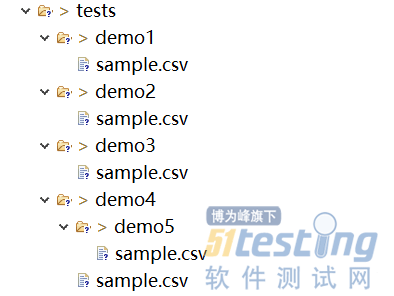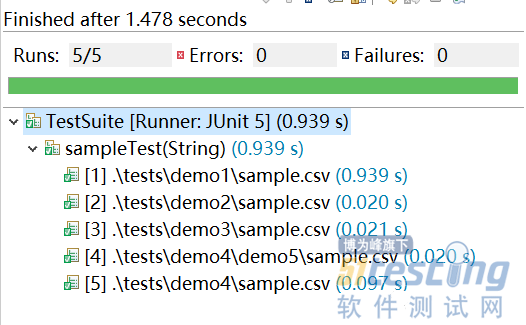主要将在之前工作的基础上,围绕参数化测试展开。
框架主要设计点:
一个用例是一个测试文件
一个用例集是一个目录
用例全部在文件中呈现,不需要写代码
主要使用的是 Junit5提供的@ParameterizedTest
引入参数化
为了能使用Junit5中重新设计的参数化测试解决方案,需要额外在pom.xml中引入junit-jupiter-params
<dependency> <groupId>org.junit.jupiter</groupId> <artifactId>junit-jupiter-params</artifactId> <version>5.5.2</version> <scope>test</scope> </dependency> |
用那种参数?
在一般的参数化测试介绍中,通常的方案是将一个文件作为数据源,如一个单一的csv文件,然后其中的某一行作为一个用例。而在我们的方案中,我们需要将整个给定目录中的csv文件作为测试用例集进行遍历执行。在评估了junit-jupiter-params所提供的下列全新的注解之后,
@ValueSource @EnumSource @MethodSource @CsvSource @CsvFileSource @ArgumentsSource |
笔者选择了@MethodSource来实现。
实现
首先来看一下@ParameterizedTest注解的用例样例
package com.demo.junit5; import java.io.IOException; import java.io.Reader; import java.nio.file.Files; import java.nio.file.Path; import java.nio.file.Paths; import java.util.Iterator; import java.util.List; import java.util.stream.Collectors; import java.util.stream.Stream; import org.junit.jupiter.params.ParameterizedTest; import org.junit.jupiter.params.provider.MethodSource; import com.demo.junit5.bean.TestStep; import com.demo.junit5.runner.MockRunner; import com.demo.junit5.runner.Runner; import com.opencsv.bean.CsvToBean; import com.opencsv.bean.CsvToBeanBuilder; import lombok.extern.slf4j.Slf4j; @Slf4j public class TestSuite { private static final String basePath=".\\tests"; private Runner runner = new MockRunner(); //@Scenario(value=".\\tests\\demo1\\sample.csv") @ParameterizedTest @MethodSource("getFiles") public void sampleTest(String testCase) { log.info("now running:'{}'",testCase); try { runCase(runner,testCase); } catch (IOException e) { e.printStackTrace(); } } } |
上述用例的意思是,通过 @MethodSource("getFiles")来获取一组参数,并依次作为testCase入参来执行sampleTest方法,从而实现所谓的参数化测试。
这里的关键是,我们需要提供一个叫做getFiles的方法。
private static List<String> getFiles(){ try { Stream<Path> walk=Files.walk(Paths.get(basePath)); List<String> result=walk.map(x -> x.toString()) .filter(f -> f.endsWith(".csv")) .collect(Collectors.toList()); return result; } catch (IOException e) { e.printStackTrace(); return null; } } |
这个方法就是去完成扫描给定目录下所有的csv文件,并将文件的完整目录纳入一个集合中并返回。
同时,我们也需要一个执行器去实现用例的执行。一个简单的样例如下:
private static void runCase(Runner runner,String testCase) throws IOException { Reader reader = Files.newBufferedReader(Paths.get(testCase)); CsvToBean<TestStep> csvToBeans = new CsvToBeanBuilder(reader) .withType(TestStep.class) .withIgnoreLeadingWhiteSpace(true) .withSeparator(',') .build(); Iterator<TestStep> csvIterator = csvToBeans.iterator(); while(csvIterator.hasNext()) { TestStep testStep =csvIterator.next(); runner.run(testStep); } } } |
执行效果
在tests目录下,简单复制几个文件和目录作为案例,然后使用之前编写的MockRunner来执行。
image.png
执行结果如下:
image.png
部分执行日志:
image.png
小结
对于不想写代码来实现自动化测试的团队来说,通过编写csv等文本文件的方式来定义用例,并由测试开发或者开发人员来根据约定提供Runner及关键字,也是一种有效的自动化实施方式。本文提供的简单案例,可以作为参考。
上文内容不用于商业目的,如涉及知识产权问题,请权利人联系博为峰小编(021-64471599-8017),我们将立即处理。


















